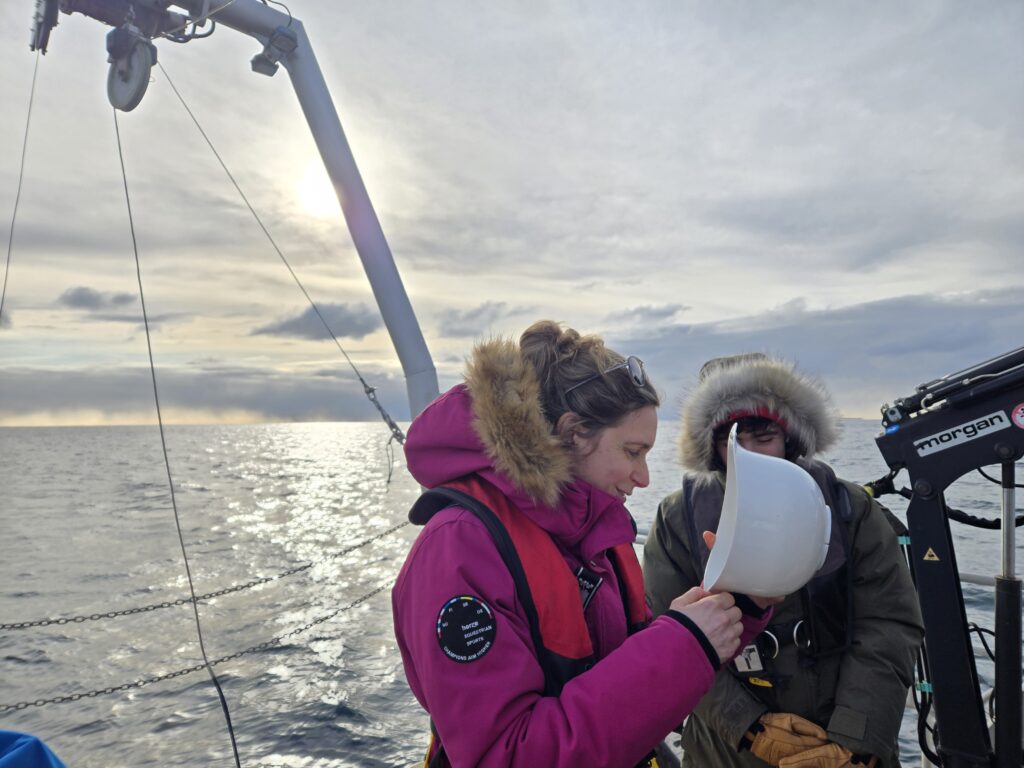
Biological Oceanographer Karen Stamieszkin especially likes a very tiny form of life: plankton.
What’s your favorite kind of animal? Why?
Oceanographer Karen Stamieszkin (pronounced stah-mee-esh-kin) has worked with some of the tiniest forms of life and also some of the biggest ones. The tiny ones – plankton – are the most exciting to her, partly because they are so important for life in our planet’s oceans…and even for those of us living mostly on land. “My mom always tells people ‘my daughter studies plankton poop.’” Read on to find out why Stamieszkin’s mother says that.
Let’s begin with an enormous ocean creature Stamieszkin worked with. When she applied for a job which involved observing the eating habits of right whales, she told the people interviewing her for the position at the Provincetown Center for Coastal Studies that she was more interested in the zooplankton the whales eat than in the whales themselves. That won her the job. So she spent several seasons figuring out how many zooplankton could be found in Cape Cod Bay and how that connected with the feeding behaviors of the local right whales.
Right whales were almost hunted out of existence by the end of the 19th century. They’re called “right” because they move slowly and float after being killed, making them relatively easy to hunt – the “right” ones to hunt. They are also very large: adults are 45 to 52 feet long and can weigh up to 70 tons – 140,000 pounds or about 63,503 kg. Right whales have been protected as an endangered species since 1972 but these days they get hit by boats or tangled in fishing gear often enough to keep their population low.
Climate change also affects right whales and other ocean creatures. The right whales are especially vulnerable because they eat mostly Calanus finmarchicus, a kind of zooplankton about the size of a grain of rice (adults are 1-2 millimeters long). (Copepods like Calanus finmarchicus are the smallest crustaceans.) Stamieszkin points out that humpback whales eat small fish and crustraceans including krill. But right whales have to follow the nutritionally rich copepod species that are their main source of food.
As the water gets warmer in places like the Gulf of Maine, these copepod populations are found further north, where the ocean water is cooler. Right whales go where their food is, which exposes them to more accidents with fishing gear and boats. (Learn more about this here.)

Karen grew up on the coast of southern Maine, in Cape Elizabeth, where she fell “in love with the natural world.” She describes her parents as “very quantitative people.” Her father studied physics and went into business. And her mother enjoyed meteorology and astronomy and became a project manager. They both worked for an insurance company. But their interests in physical sciences meant that they could help Karen with her math homework. And “we gardened, we hiked, we went camping, and we went to the beach every day in the summer.”
Perhaps all that time outside on the Atlantic sea coast is why Karen thought she might become a marine biologist. She also considered studying Russian literature but realized that “I could always get into deep reading but I probably could not do science on my own.” She “had to get it in college if I wanted to be able to do it as a career.”
At Yale University as an undergraduate, she took all of the oceanography classes available. The textbook for a biological oceanography course made her think “Ah, this is home.” For another class, she studied satellite imagery of chlorophyll in the south Pacific ocean. This helped her identify the location and quantities of phytoplankton, which she compared with information on tuna landings and changes in the climate. Looking at fishing reports can give scientists a sense of changes in the populations of the species people catch for food. “That project was my first foray into crunching numbers.”
When you hear the word “migration,” you may think of people or perhaps birds or butterflies moving across horizontal distances. But planet Earth’s greatest migration happens vertically – up and down. Called the DVM (diel vertical migration), this is the movement of zooplankton and some fish between the ocean’s euphotic zone (the top layer of water, which sunlight can reach) down to the darker zones below it. They swim up to find food, usually at night when it’s more difficult for predators to find them. And they swim down to avoid those predators, to avoid the sun’s ultraviolet light, and to ride the water’s currents to areas with more food. The sun’s heat also influences their movement.
Stamieszkin and her colleagues at Bigelow Laboratory for Ocean Sciences, where she has worked since 2017, use special tools to collect zooplankton at different ocean depths. They sample life in the water at a number of locations, studying different subjects including the ocean’s biological carbon pump and ways that the DVM contributes to the sinking of carbon deep into the ocean. Niskin bottles they put into the water and close only when they reach the depths the scientists wish to study catch samples of plankton and the water they live in.

Bigelow researchers also use very fine nets to collect plankton – nets whose openings are only 200-300 micrometers wide (there are 1,000 micrometers in one millimeter! A micrometer is one millionth of a meter, too small for the human eye to see).
How many of the plankton in a given location are phytoplankton – the ones which can do photosynthesis and are more like plants than animals? They live in the euphotic zone, where 99 percent of the light in the ocean is, at its surface. By measuring micrograms or milligrams of chlorophyll per liter of water collected, Stamieszkin and the other scientists can estimate how many phytoplankton are present in a given area. They also measure the pH of the water, the oxygen in it, and different particles.
In 2018, Stamieszkin and her colleagues sampled water in the northeast Pacific ocean, exploring and measuring evidence of carbon that plankton send down to the ocean floor, where it may be stored for thousands of years. Keeping that carbon out of the atmosphere can slow global warming. Working on one of two ships of scientists, Stamieszkin was “always doing … new experiments to measure the fecal pellet production rates of different zooplankton” – plankton which eat other plankton, rather than doing photosynthesis.
Fecal pellets are zooplankton’s … poop. One of the main ways they move carbon deeper in the ocean is by pooping. The scientists stacked 10 nets on top of each other, closing one and opening the next with instructions transmitted by a computer. This helped them see where the different plankton were located. It took a few hours to tow the nets 1,000 meters down and back up.
Once the samples arrived at the surface, they dumped them into a bucket and “everyone scramble[d] to see what’s in there because it’s so exciting.” Then they took different parts of the ocean water they brought up and used various techniques to explore them. Some were stored, some dried, some weighed, and some burned. Burning helps researchers find out how much carbon, nitrogen, or hydrogen the water contains. And they looked at some with a microscope, which helped them count the tiny animals living in the water. How much poop – sorry: How many fecal pellets – does each community of plankton produce? How quickly? Those are some of the key questions Stamieszkin and her colleagues explored as they gathered information that can help us better understand the movement of carbon dioxide and other forms of carbon into and through the oceans.
Recently, Stamieszkin and Nicole Poulton, another senior research scientist at Bigelow, have been looking at mixotrophs – the unexpectedly large numbers of plankton who can do photosynthesis and eat other organisms for food. This makes them more flexible – able to find food in different circumstances. Learn more about mixotrophs and Bigelow scientists’ work on them here.
Understanding how carbon moves through the ocean may help us take better advantage of the huge communities of plankton. We might “potentially increase the amount of carbon that sinks into the deeper ocean” by enlarging the amount of phytoplankton available for zooplankton to eat and turn into fecal pellets. But if much of the carbon dioxide produced when phytoplankton do photosynthesis stays at the top of the ocean’s water and enters the atmosphere above its surface, that might speed up rather than slow down global warming. Stamieszkin’s and her colleagues’ research will help determine how to manage the movements of carbon in ways that may make life more comfortable for all creatures, from the right whales to the copepods they eat.



